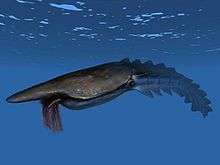Aegirocassis
| Aegirocassis benmoulai Temporal range: Early Ordovician | |
|---|---|
 | |
| Recreation | |
| Scientific classification | |
| Kingdom: | Animalia |
| Class: | †Dinocaridida |
| Order: | †Radiodonta |
| Family: | †Hurdiidae |
| Genus: | †Aegirocassis |
| Species: | †A. benmoulai |
| Binomial name | |
| Aegirocassis benmoulai Van Roy, Daley, & Briggs, 2015[1] (nom. corr. Van Roy et al in press[2]) | |
Aegirocassis is an extinct genus of anomalocarid arthropod belonging to the family Hurdiidae that lived 480 million years ago during the early Ordovician. It is known by a single species, Aegirocassis benmoulai. A fossil of A. benmoulai from the Fezouata biota, Morocco was discovered by and named after Mohamed Ben Moula, a fossil collector who recognized its rare characteristics and brought it to the notice of a professional paleontologist, Peter Van Roy, at the Ghent University in Belgium.[3]

Van Roy initiated scientific study of the fossil,[4] the earliest known of a "giant" filter-feeder discovered to date.[5] Aegirocassis is considered to have evolved from early predatory anomalocarids.[6] At the time of its existence, A. benmoulai was possibly the largest animal in the world.[3] The length was described as exceeding 2.0 metres (6.6 ft) in the scientific journal Nature.[1]
The fossil was preserved with exceptional three-dimensional detail, unlike most other anomalocarid fossils, in which the animals are flattened.[7] The quality of three-dimensional preservation has shed light on the nature of anomalocarid trunk flaps. Each trunk segment of the Aegirocassis benmoulai specimen has both a ventral and a dorsal pair of flaps. Several details seen clearly in the specimen led to a review and reassessment of research of existing specimens and, most importantly, to the conclusion that the ventral pair are homologous with lobopodous walking limbs in arthropods, and the dorsal pair are homologous with the flaps of gilled lobopodians and exites of the Cambrian biramous limb.[1][8]
Note on taxonomy
The species was originally termed A. benmoulae, but was corrected to A. benmoulai to comply with the terms of the ICZN.[2]
References
- 1 2 3 Van Roy, Peter; Daley, Allison C.; Briggs, Derek E. G. (2015). "Anomalocaridid trunk limb homology revealed by a giant filter-feeder with paired flaps". Nature. 522 (7554): 77–80. doi:10.1038/nature14256. ISSN 0028-0836.
- 1 2 Van Roy, Peter; Briggs, Derek E. G.; Gaines, Robert R. (2015). "The Fezouata fossils of Morocco; an extraordinary record of marine life in the Early Ordovician". Journal of the Geological Society: 2015–017. doi:10.1144/jgs2015-017. ISSN 0016-7649.
- 1 2 Duhaime-Ross, Arielle (March 11, 2015). "This giant lobster ancestor was once the biggest animal on Earth". The Verge. (Includes an account of Ben Moula showing his fossil to Van Roy).
- ↑ "Human-Sized 'Lobsters' Lived on Earth 480 Million Years Ago". Sci-News.com. 12 March 2015. Retrieved 13 March 2015.
- ↑ Banoo, Sindya N. (11 March 2015). "Fossil Tells of 520-Million-Year-Old [sic] Creature Like a Giant Lobster". New York Times. Retrieved 12 March 2015.
- ↑ Van Roy, Peter (12 March 2015). "Fossils of huge plankton-eating sea creature shine light on early arthropod evolution". The Conversation. Retrieved 16 March 2015.
- ↑ "Fossil 'lobster' as big as a human". BT.com. 11 March 2015. Retrieved 12 March 2015.
- ↑ Perkins, S. (2015-03-11). "Newly discovered sea creature was once the largest animal on Earth". AAAS. Retrieved 2015-03-13.